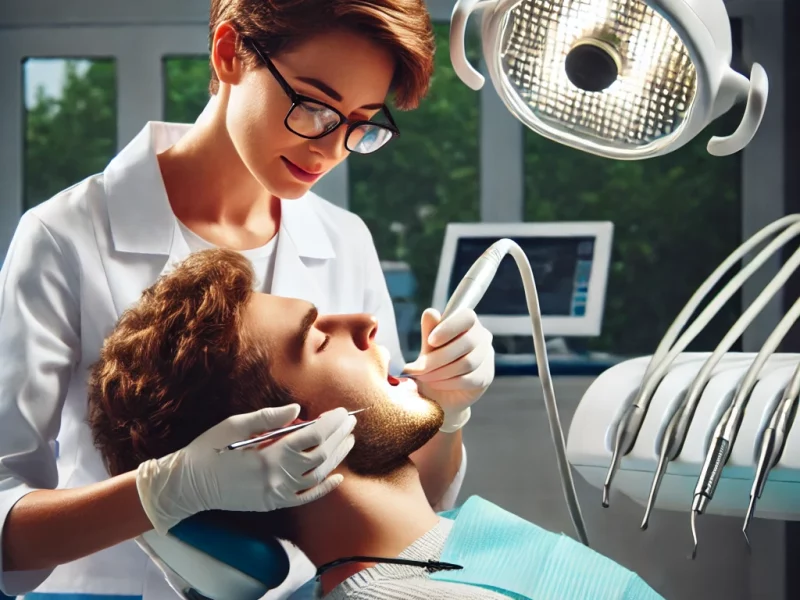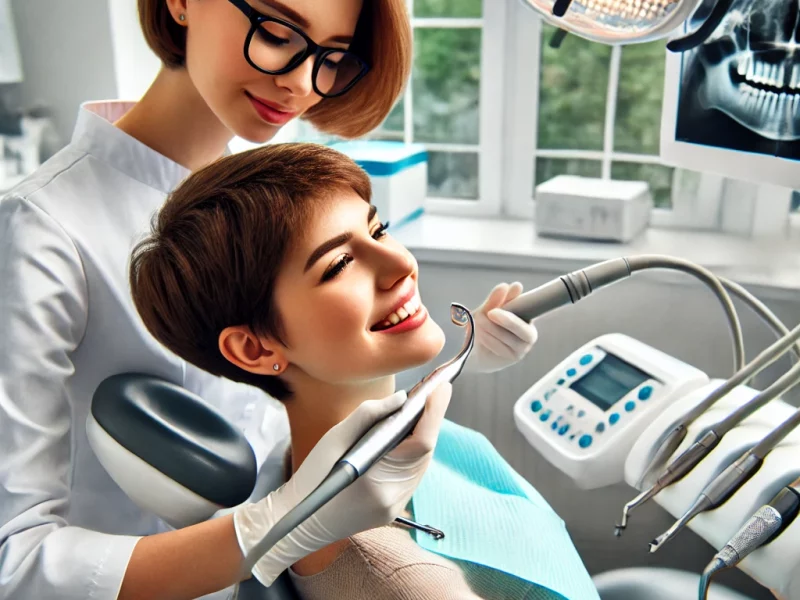How Does Airflow Dental Cleaning Work?
Airflow Dental Cleaning is a modern technique that revitalizes your smile without the discomfort often associated with traditional dental cleanings. This method uses a gentle stream of air, water, and fine powder to effectively clean your teeth, reaching areas that are tough to get to with regular brushing. Perfect for removing stains and plaque, it’s a quick, painless process that leaves your mouth feeling fresh and clean.

What Is Airflow Dental Cleaning?
Airflow Dental Cleaning is a modern dental hygiene treatment that enhances traditional methods with a gentle yet effective approach. It utilizes a mixture of air, fine powder, and water to clean teeth thoroughly. This technique quickly removes dental plaque, surface stains, and soft deposits without the need for direct scraping against the teeth, making it a comfortable option for patients.
Airflow Dental Cleaning Purpose
Its primary purpose is to provide a deeper clean that regular brushing can’t achieve, especially in hard-to-reach areas of the mouth, and is particularly beneficial for patients with sensitive teeth or those who find traditional scaling uncomfortable. This method not only improves oral health by preventing gum disease and cavities but also brightens teeth, giving you a fresher, cleaner smile with minimal discomfort.
The Step-by-Step Process of Airflow Cleaning
The step-by-step process of Airflow Dental Cleaning is straightforward and designed to maximize comfort and effectiveness while minimizing discomfort. Here’s what patients can expect during their visit with their Brisbane dentist:
Preparation: First, the dentist conducts an oral examination to assess the condition of your teeth and gums. This helps them target areas that need the most attention.
Protection: To protect your gums and soft tissues from the jet of air and powder, the dentist may apply a protective barrier or gel. Your lips and eyes are also shielded for safety.
Cleaning Process: The Airflow device is then used. It emits a controlled stream of warm water, compressed air, and fine powder (typically sodium bicarbonate, erythritol, or glycine). The mixture is precisely directed towards the teeth, effectively dislodging plaque, removing surface stains, and cleaning both above and below the gum line. The process reaches into crevices that traditional brushing can’t manage, ensuring a thorough clean.
Rinsing: After the cleaning, any residual powder and debris are rinsed away using water, leaving your mouth clean and refreshed.
Final Check: The dentist will do a final inspection to ensure all areas are clean. They will also provide advice on how to maintain oral hygiene based on the results of the cleaning.
Post-Care Guidance: Before you leave, you might receive tips for at-home dental care tailored to maintain the cleanliness and health achieved from the Airflow cleaning, along with recommendations for follow-up visits.
This entire process typically takes about 30 minutes, depending on the amount of buildup and staining. Patients usually notice an immediate difference in how clean and smooth their teeth feel, with no discomfort during the procedure.
Is Airflow Cleaning Right for You?
Deciding if Airflow Dental Cleaning is right for you involves understanding both the benefits and considerations specific to your dental health. Here’s a simple breakdown to help you determine if this modern dental cleaning method suits your needs:
Sensitivity and Discomfort: If you often experience discomfort or pain during traditional dental cleanings due to sensitive teeth or gums, Airflow cleaning might be a better choice. This method is gentler because it uses a mix of air, water, and fine particles to clean without direct contact, reducing sensitivity and discomfort.
Stain Removal Needs: Airflow cleaning is highly effective at removing surface stains from teeth, especially those caused by coffee, tea, tobacco, and wine. If you’re looking to brighten your smile and remove these types of stains, Airflow can provide noticeable results in a single session.
Dental Conditions: People with braces, dental implants, or veneers can benefit from Airflow cleaning. It safely cleans around and under orthodontic brackets and delicate restorations without causing damage, which is not always the case with traditional scaling methods.
Dental Health Goals: If your goal is to maintain excellent oral hygiene with minimal discomfort and quick results, Airflow cleaning aligns well with these objectives. It effectively removes plaque and bacteria, even in hard-to-reach areas, preventing gum disease and improving overall dental health.
Frequency of Visits: Those looking for efficient dental visits may find Airflow cleaning appealing. The procedure is quicker than traditional methods, usually taking about 30 minutes, making it convenient for people with busy schedules.
Medical History: If you have certain medical conditions that affect oral health, such as diabetes or heart disease, maintaining optimal oral hygiene is crucial. Airflow cleaning can be a part of this regimen, offering thorough cleaning without added stress on your teeth and gums.
In summary, Airflow Dental Cleaning is suitable for almost anyone looking for a less invasive, more comfortable, and efficient dental cleaning method. However, it’s always best to consult with your dentist, who can advise based on your specific dental and medical history to ensure it’s the best option for you.
Benefits of Choosing Airflow Cleaning Over Traditional Methods
Choosing Airflow Dental Cleaning over traditional methods such as scaling and polishing offers several distinct benefits, making it a preferred option for many patients and dentists alike. Here’s a detailed comparison highlighting the advantages:
Comfort: Airflow cleaning is notably more comfortable than traditional scaling. Traditional methods often involve mechanical scraping and may cause discomfort, especially for those with sensitive teeth or dental anxiety. Airflow uses a gentle jet of air, water, and fine powder to remove plaque and stains without direct contact, making the process pain-free and less intimidating.
Efficiency: The process is fast and effective. A complete Airflow cleaning session can be completed in as little as 30 minutes, compared to traditional methods, which may take longer. This efficiency is beneficial for both patients looking to save time and dental practices aiming to increase patient turnover.
Safety: Airflow cleaning minimizes the risk of gum recession and damage to the enamel, which can sometimes occur from the more aggressive scraping techniques used in traditional cleaning. The gentle nature of the Airflow method makes it safer for regular use and ideal for maintaining long-term dental health.
Effectiveness in Stain Removal: Airflow is highly effective at removing surface stains from the teeth, caused by things like coffee, tea, and smoking. Traditional polishing might not remove all surface stains as effectively, particularly those in harder-to-reach areas.
Versatility: It can be used on various dental surfaces, including natural teeth, veneers, implants, and orthodontic brackets, without causing damage. This versatility is something traditional methods can’t always offer, as they may pose risks to delicate surfaces.
Better Access to Hard-to-Reach Areas: The mixture of air and water in Airflow cleaning can reach places that manual tools might miss, such as deep grooves and the interdental areas. This thorough cleaning helps in preventing periodontal disease by removing hidden plaque.
Reduced Chemical Use: Unlike some traditional methods that may require stronger chemical agents for deep cleaning, Airflow uses primarily water, air, and a biocompatible powder, making it a more natural choice.

What to Expect After an Airflow Cleaning Session
After an Airflow Dental Cleaning session, here’s what you can typically expect, along with some aftercare tips to ensure the best results:
Typical Outcomes
Immediate Cleanliness: Your teeth will feel notably cleaner and smoother right after the session. Airflow cleaning efficiently removes plaque and surface stains, making your teeth look brighter almost immediately.
Enhanced Oral Comfort: Many patients report a pleasant feeling with no discomfort during and after the procedure, especially when compared to traditional scaling methods.
Improved Gum Health: Because Airflow cleaning effectively removes bacteria along the gum line and between teeth, you might notice less gum bleeding if you previously had mild gum issues.
Potential Side Effects
Airflow Dental Cleaning is generally well-tolerated, but like any dental procedure, there are a few potential side effects to be aware of:
Sensitivity: Some patients may experience temporary sensitivity to temperature. This is usually minor and fades within a few hours.
Minor Gum Irritation: In rare cases, the jet of air and powder might irritate sensitive gums, but this typically resolves quickly.
Aftercare Tips
Good Oral Hygiene: Continue brushing twice a day and flossing regularly. Consider using a toothpaste designed for sensitive teeth if you experience any post-treatment sensitivity.
Avoid Staining Substances: Immediately after the cleaning, try to avoid coffee, tea, red wine, or smoking for at least 24 hours to prevent restaining your freshly cleaned teeth.
Follow-Up: Follow your dentist’s recommendations for regular check-ups and cleaning sessions to maintain dental health. Airflow cleaning doesn’t alter the need for routine dental care.
Hydration: Drinking plenty of water helps to rinse any remaining particles and keeps your mouth hydrated.
Following these guidelines will help you maintain the results of your Airflow Dental Cleaning and keep your smile looking its best. If you experience any prolonged discomfort or unusual symptoms, don’t hesitate to contact your dental professional.
What is Airflow dental cleaning?
Airflow dental cleaning is a modern method that uses a stream of air, water, and fine powder to remove plaque and surface stains from teeth efficiently. It’s a gentle alternative to traditional scaling.
How long does an Airflow cleaning session take?
An Airflow cleaning session typically lasts about 30 minutes, making it a quick option for maintaining dental hygiene.
Is Airflow cleaning painful?
No, Airflow cleaning is generally not painful. It’s known for being a gentler option compared to traditional dental cleaning methods.
How often should I get an Airflow dental cleaning?
Dental professionals recommend Airflow cleaning every six months, similar to standard dental check-ups, but this can vary based on individual dental health.
Can Airflow cleaning remove tartar?
Airflow cleaning is effective at removing plaque and minor tartar but may not remove hardened tartar as effectively as manual scaling.
Is Airflow cleaning safe for children?
Yes, Airflow cleaning is safe for children, offering a less intimidating and gentle cleaning method.
Are there any side effects of Airflow dental cleaning?
Side effects are minimal but may include temporary sensitivity or minor gum irritation immediately following the procedure.
Will Airflow cleaning make my teeth whiter?
Airflow cleaning can significantly improve the whiteness of your teeth by removing most surface stains, but it is not a bleaching treatment.
What types of stains can Airflow dental cleaning remove?
It is particularly effective at removing stains caused by coffee, tea, tobacco, and wine.
Is Airflow dental cleaning suitable for people with braces?
Yes, it’s an excellent choice for individuals with braces as it can clean around brackets and wires effectively without causing damage.
Can Airflow cleaning be used on dental implants and veneers?
Absolutely, Airflow cleaning is safe for dental implants and veneers, cleaning them without causing any harm.
What does Airflow dental cleaning feel like?
Most people describe it as a gentle jet of air and mist, which is much less invasive than the scraping done during traditional cleanings.
How does Airflow cleaning benefit my overall oral health?
It improves oral health by efficiently removing plaque and bacteria, reducing the risk of gum disease and cavities.
Can Airflow cleaning cause any damage to my enamel?
No, the procedure is designed to be gentle on teeth and does not damage the enamel.
How do I maintain my teeth after an Airflow cleaning?
Maintaining good oral hygiene with regular brushing and flossing, along with avoiding stain-causing foods and beverages, will help keep your teeth clean post-treatment.